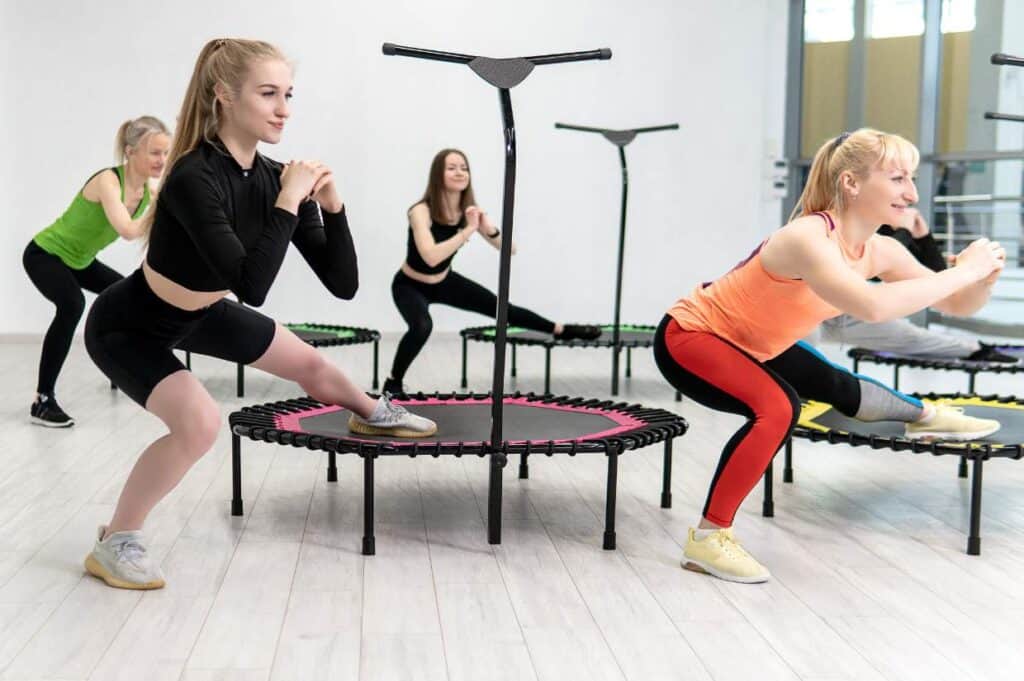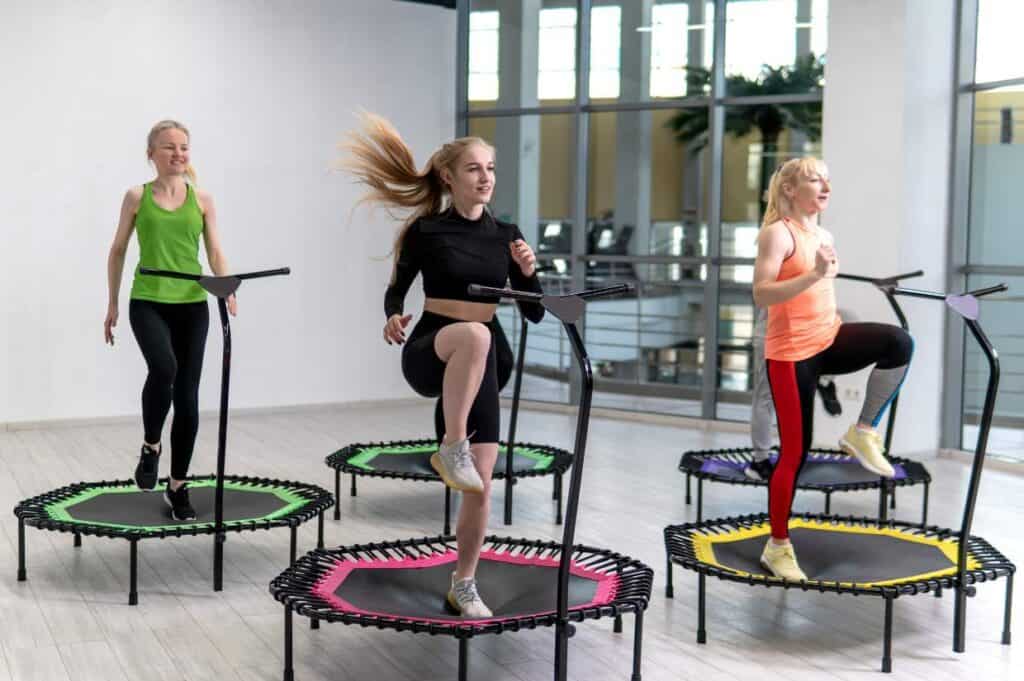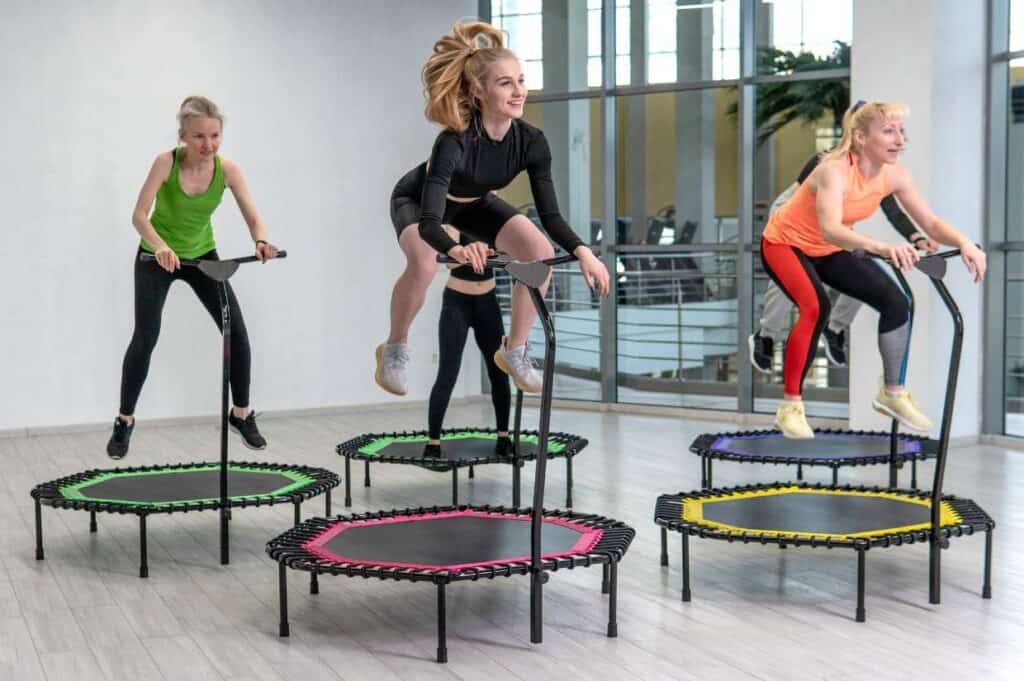Rebounding is a low-impact aerobic exercise that is meant to boost your endurance, strengthen your muscles, raise your heart rate and much, much more. All you need is a mini trampoline and enough space to jump, and you’ll get to reap the benefits of this fun yet gentle exercise.

These statements have not been evaluated by the Food and Drug Administration. Please see the disclaimer below for more information.
Jumping on a trampoline sounds like something from your childhood. Yes, trampolines provide a great way for kids to exercise and have fun at the same time, but did you know that trampoline exercise can also be the perfect workout for adults?
What is rebounding?
Rebounding is a form of aerobic exercise done on a mini trampoline. Essentially, the workout is all about jumping up and down, much like using a jump rope or doing jumping jacks. However, it’s a much gentler exercise because your feet are not absorbing the impact of a rigid floor.
That’s why I like turning to this workout when my feet are sore, or I don’t feel like engaging in high-impact cardio. It’s also my favorite late afternoon exercise to reset my circadian rhythm, as it’s not too intense to mess up my energy levels when it’s almost time for bed.
You can combine different types of exercise with rebounding or modify it to fit your needs and preferences. For one, you can bounce up and down without lifting your feet off the trampoline for a lower-impact workout. On the flip side, you can try jumping as high as you can to strengthen your leg muscles and raise your heart rate.

What are the benefits of rebounding?
Adding rebounding to your fitness routine can make way for several health benefits. These may include:
Boosts energy
According to doctors from Harvard Health, cardiovascular exercises like rebounding help produce more cellular energy, which, in turn, gives you more fuel. Additionally, exercise helps the body use oxygen more efficiently and energizes you throughout the day. More energy comes with other benefits, such as allowing you to engage in more physical activity, keeping you mentally sharp and boosting your immune system.
Helps protect your bones
Rebounding helps support strong bones, protects against bone loss and reduces the risk of fractures, as evidenced by a Journal of the Medical Association of Thailand study on the effects of mini trampoline exercises on bone health. It’s a go-to workout, especially if you’re between 30 and 50 years old when bone loss typically starts.
“Rebounding is a great cardio workout you can do at home. With less impact than running, adding a rebounding workout to your routine can help you improve lower body strength, cardio endurance and prevent osteoporosis by improving bone strength!”
— Shelby, Fit as a Mama Bear
May help with weight loss
A study by the Journal of Sports Medicine and Physical Fitness on the effect of mini trampoline exercise on overweight women showed that rebounding is an effective form of weight loss and overall health improvement. This was evidenced by a decrease in weight, fat and blood pressure in participants.
Plus, rebounding is easier on the joints, bones and respiratory system than running or jogging. This means that it can help you stick to your workout because you’re not constantly out of breath or in pain, which can be a huge roadblock to getting regular physical activity.
Strengthens muscles
A systematic review in the Sports Medicine journal of the effects of jumping exercises on muscular health revealed that it can increase the strength your skeletal muscles can exert, especially in older adults. Building muscle strength can prevent muscle loss as we age, and having more muscle mass means your body burns more calories, even when at rest.
Personally, I prioritize exercises that help build muscle and always make sure to eat enough protein to fuel synthesis. Aside from being an energy source, rebounding helps me turn protein into muscle, allowing me to do more demanding exercises.
Improves balance and coordination
Of course, you’ll need some level of balance and coordination when you start rebounding. However, the requirement is not that high, and you don’t have to start with high-level jumps, anyway.
As you go along, jumping on a trampoline can increase your balance, coordination and functional mobility. These benefits are particularly helpful for older adults with an increased risk of falls and a fear of falling. For younger people, good balance and coordination come with the added benefit of improved athleticism.

Increases lymphatic drainage
The lymphatic system is made up of tissues and organs that help protect the body from diseases and infections and flush toxins and other unwanted substances from it. It relies on our body’s movements, such as jumping, to initiate lymphatic drainage.
Lymphatic drainage can help reduce inflammation, according to a study published on the Frontiers of Immunology. Increased lymphatic flow or drainage is particularly helpful for people with edema and inflamed skin. It also benefits inflammatory bowel disease (IBS), rheumatoid arthritis and chronic skin inflammation.
Relieves stress
Along with a glass of wine, exercise is one of my favorite natural stress relievers. However, I have to admit that some forms of exercise are too intense to get the relief that I need.
Rebounding is my go-to alternative for high-intensity workouts. It gives me all those nice endorphins from getting my whole body moving, but it’s gentle enough that I’m not sore for days later.
Plus, rebounding helps me stay motivated. Some days, you don’t want to go to the gym for a full 1-hour workout, so why not hop on the mini trampoline instead?
More fun and portable workout
Remember all the fun you had jumping on a trampoline as a kid? Well, there’s no reason to miss out on all that enjoyment as an adult, even though you’re doing it on a smaller trampoline.
Another benefit of rebounding is that you can do it almost anywhere. I recommend rebounding in an open, outdoor area with grass in case you need to cushion a fall. However, you can do it indoors or even in front of the TV as long as you have enough space.
Safety tips for rebounding
Just like any exercise, rebounding comes with several risks. Keep these safety tips in mind before jumping into this new exercise:
- Make sure you have enough space. As we’ve said before, position your trampoline in a clear area, preferably outdoors. This way, you won’t bump into anything in case you fall.
- Jump within your skill level. Always start slow, like bouncing up and down instead of full-on jumping. Work your way up until you feel more comfortable doing higher-level jumps.
- Inspect your trampoline. Look for any tears or broken pieces before you start each session. Never jump on a flimsy trampoline.
- Stay hydrated. Drink water frequently throughout the day.
Final thoughts
Rebounding is an excellent form of exercise that’s easy on the body yet provides so many benefits, such as better energy levels, stronger bones, increased muscle mass and more. If you’re tired of your regular workouts, add rebounding to the mix. Alternatively, make rebounding your main workout and reap the benefits of low-impact cardio.
Disclaimer: These statements have not been evaluated by the Food and Drug Administration. The contents of this article, made available via Food Drink Life, are for informational purposes only and do not constitute medical advice. The Content presented here is not intended to be a substitute for professional medical advice, diagnosis, or treatment. Always seek the advice of a qualified healthcare provider with any questions you may have regarding a medical condition or dietary changes. Reliance on any information provided by this article is solely at your own risk.
Jessica Haggard is dedicated to helping people cook easy everyday recipes focusing on bioavailable and nutrient-dense foods. She helps people overcome food allergies and discover healthy recipes that make a difference in their health with gluten-free, low-carb and keto cooking at Primal Edge Health.